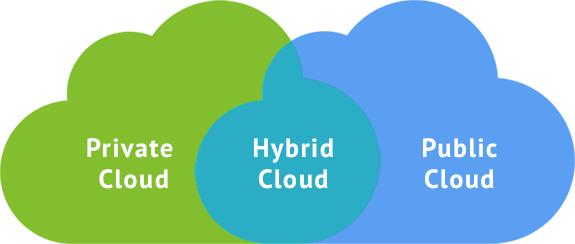
Fundamentals – Flavors of Cloud
The word “CLOUD” is a trendy buzzword in today’s market, with many obscure definitions. Ultimately, it’s a method of pooling technology resources in order to quickly deliver “IT as a Service” in whole, or any part of the technology stack separately. The following subheadings are types of clouds seen in the world today.
Private Cloud
Within the modern data center, a private cloud is often used to deliver Infrastructure as a Service (IaaS) or Platform as a Service (PaaS).
IaaS focuses on the expedient delivery of on-demand, consumable Network, Compute, Storage and Operating Systems to a user base and/or project: software developers and programmers, infrastructure engineers, marketing campaigns, application development – any consumers of the resources.
PaaS is the next stage, including additional layers of software with the OS, called Middleware, along with the configured components of an application stack provisioned simultaneously: Database Server, Web/API Servers.
Code Delivery is the pinnacle offering, enabling a developer to simply “drag and drop” a version of application coding into an application stack (PaaS), ready to use within minutes.
A true private cloud is built like a “sandbox”, where virtual machines are dynamically created and destroyed on-demand with very few mouse clicks, through a single interface or web portal. Putting the technology in place is fairly easy with the right technical personnel, but the most challenging parts of cloud implementation are: Design, Governance, Integration and Operations. Keeping the sandbox dynamic is very difficult without isolation from production systems. Turning an entire data center, with production systems, into a cloud is expensive; this requires a Cloud PM or Service Manager to oversee all operations. The more integration with existing systems, the more mature the organization has to be – able to focus on the converged delivery of all technology and the unity of the personnel responsible, silo-breaking.
Public Cloud
Outsourcing the cloud to a service provider is always an option. The public cloud providers have mastered the operations of provisioning, ensuring vast amount of resources at their clients’ disposal. The retail markup or the datacenter is obviously more than the cost of private cloud – so why do so many companies turn to the service providers? The answers are convenience and availability. Some projects, like an email blast for a marketing campaign, require more servers than a company can afford to buy and maintain year-round.
Public clouds are great for bursting, or provisioning a multitude of servers quickly and for a limited time. But keep in mind that service providers do not provide Governance, or policies and processes around the use of their service – they will send a bill regardless if the provisioned servers are idle, or being used, because it’s a small percentage of their datacenter that cannot be sold to another client.
Becoming a public cloud provider requires mastering Process through automation and orchestration – scriptable communication between all software and services within the datacenter. The highest levels of availability and security compliance are required to attract customers, especially the federal and financial sectors.
Hybrid Cloud
An increasingly popular solution is to use both private and public for diversity and disaster recovery. Having the cost-effective private cloud with the vast resources of a public service provider are now built into several software suites, thus merging what used to be two separate solutions. Again, the key is Governance, ensuring the resources are used responsibly and with some accountability through a chargeback or showback cost calculation to the consumer.
Chargeback is actual billing to the department or user for the resources consumed, while showback is just an estimated cost to the business, presented to the consumer – usually formatted to daily, weekly or monthly usage of resources.





